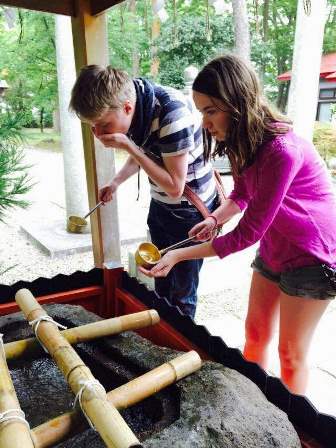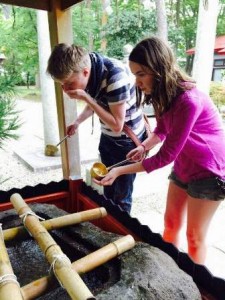
Submitted by Heather McAdams on the 2015 fall semester study abroad program in Akita, Japan…
Within the first week of coming to Japan and moving into Akita International University, me and my fellow international students had already started forming a community. As part of this community, most of us went to spend the day in Akita City during the first weekend. The city is 8 miles away from the university and not particularly convenient to reach, so many of us took advantage of the one-day-only bus deal that the university offered that first weekend: a free (!) shuttle service to the city. Hence why many students went to explore the city.
Most of my time in the city was preoccupied with exploring Senshu Park, a park at the center of Akita City. The remains of a castle, the park’s centerpiece, is a historic watch tower that overlooks gardens and a shrine. The shrine in particular is a great cultural experience. I also had the good fortune to be introduced to the shrine customs by a Japanese tour guide. The woman saw my group as we wandered into the park, and offered to show us the former castle grounds for free. The catch? She didn’t speak a word of English. Fortunately, I happened to be with a group of students who spoke Japanese much better than I did.
As the volunteer guide showed us around, one of my friends in the group paraphrased her explanations. As we approached the shrine, she gave very clear instructions (“walk to the right as you enter the gate and approach the shrine–historically, only people at the level of an emperor could walk down the middle”), but I still felt like I might fumble with a custom. The custom of washing your hands was particularly difficult to master when I could barely understand the guide. Just past the shrine gate was a pool of water and a makeshift ladle. First, you pick up the ladle with your right hand, fill it up, and pour the water over your left hand, making sure not to get any water back in the pool. You repeat the process for your right hand, then cup one of your hands to pour some water into it. You drink it from your hand, swish it around in your mouth, and then spit. Finally, you tilt the ladle vertically so the water spills down the handle to wash it.
Next, we rang the bells at the shrine. The bells are attached to a large rope that must be pushed side to side to ring the bell, and a series of bows and claps are customary to push the rope. As I recall, it was one bow at the bottom of the steps to the shrine, two bows at the top, and two claps before you can ring the bell. The guide also put in an offering at the shrine to pray for our group, which was a very kind gesture.
Finally, our last stop at the shrine was a small house that sold omamori. Omamori are Japanese “luck charms”–westerners who have heard of omamori tend to think of them as such, but in the context of the Shinto religion, they mean much more on a spiritual level. They are small cloth pouches that are tied together at the top, and hold something inside (usually some wood or tough paper with “lucky” phrases on it). Most shrines sell them, just as many churches sell holy water, but they aren’t meant to be general souvenirs–they should be specific to the person who will carry the omamori. For example, I would get a sick friend an omamori specifically for health, as indicated by the calligraphy on the front of the omamori.
All in all, our first outing in Akita City was an amazing cultural experience, and I will no doubt be back!

